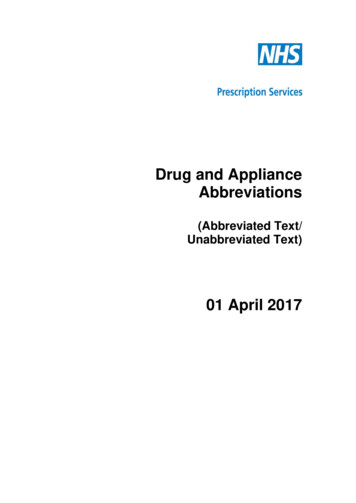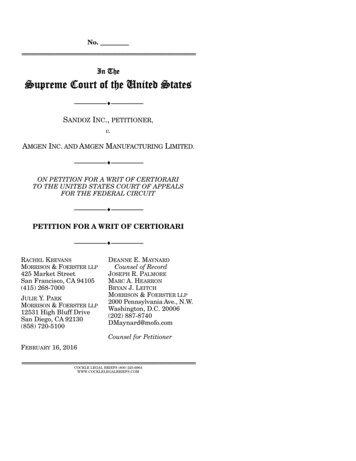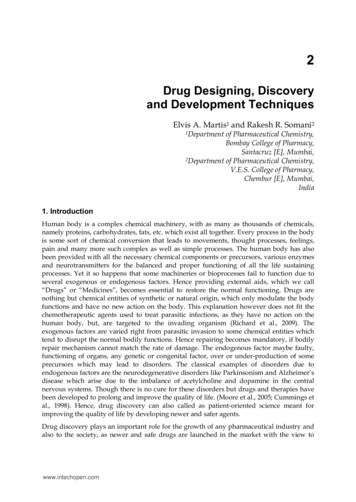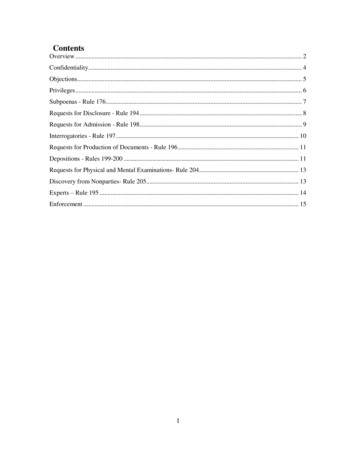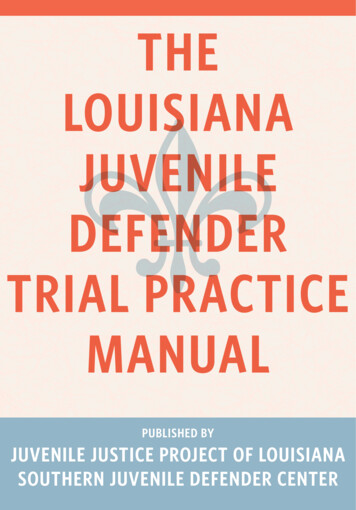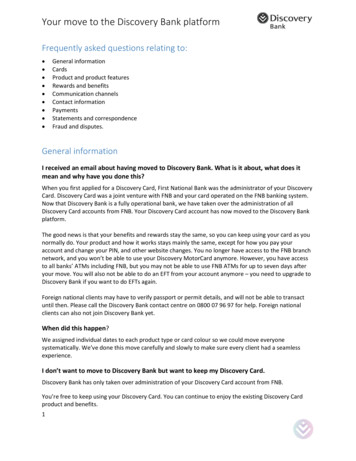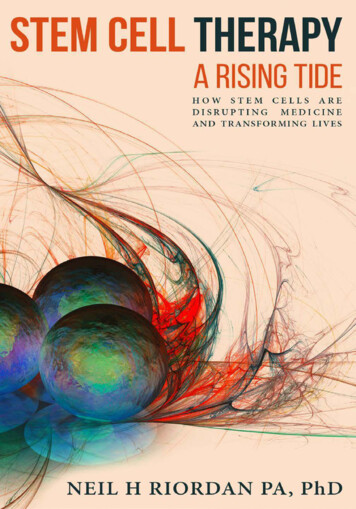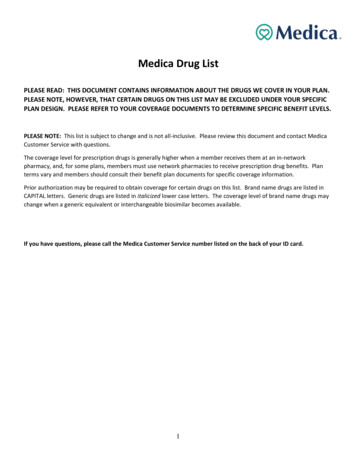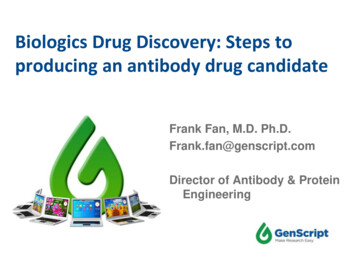
Transcription
Biologics Drug Discovery: Steps toproducing an antibody drug candidateFrank Fan, M.D. Ph.D.Frank.fan@genscript.comDirector of Antibody & ProteinEngineering
About GenScriptGene ServicesProtein ServicesDiscovery BiologyServicesMake Research EasyPeptide ServicesAntibody ServicesCatalog Products2
Discovery Biology ServicesAntibody and Protein Engineering Single domain antibody generation Antibody sequencing Affinity maturation and humanizationIn-vitro Pharmacology CellPower custom stable cell line for assays GenCRISPR custom knock-out or knock-in cell lines Cell-based assays and Ion channel and GPCR assaysIn-vivo Pharmacology Tumor models including SC xenograft, orthotopic and syngeneic Bioluminescence imaging of tumors Fibrosis modelsMake Research Easy3
Presenter BioFrank Fan, M.D. Ph.D. Director, Antibody and ProteinEngineering at GenScript Highly customized antibody libraries Human B cell immunologist specialized inantibody tolerance research Published over 40 papers, in journals such as NatureMedicineDevelopment of new immunology assays: Live-cell fluorospot Single B-cell RT-PCR of BCR VH and VLMake Research Easy4
1Biologics discovery overview2Challenges in antibody discovery3Antibody discovery process4GenScript’s discovery services5SummaryMake Research Easy5
Growing Trend for Biologics Biologics accounted for one-third of new medicineapprovals in the past decade Antibody-based – anti-VEGF, anti-IL-12 and IL-23Vaccines – Human papilloma virus (HPV)RNAi – Duchenne Muscular Dystrophy (DMD)Cell-based – Autologous cellular immunotherapy for castrate-resistantprostate cancer Gene therapy – adeno-associated virus (AAV) delivery of neurturin, torestore damaged cells in Parkinson’s patients Growing trend for more biologics based therapies,especially monoclonal antibodies 338 monoclonal entities currently in clinical trials 170 monoclonal antibodies in development for cancerData from Medicines in development: Biologics 2013 Report. Presented by America’s Biopharmaceutical Research Companies (PhRMA).Make Research Easy
Challenges in Antibody Discovery Human anti-mouse antibody (HAMA) response Non-specific targeting of antigens on healthy cells Toxicity caused by binding to surface antigens shedinto circulation Limitations in biological activity due to location ofbinding and stimulation of immune response More costly to develop than small moleculetherapeuticsMake Research Easy7
Antibody Discovery lidation ionFactors to consider: Where is the process starting from? Is the target alreadyvalidated? Which antibody platform to use? How many leads to move forward into optimization? What are the best optimization approaches? How do we maximize translation of efficacy into theclinic?Make Research Easy8
Target ateValidationTarget identification: Identifying druggable targets,determining whether targets are good antibody candidates. Factors to consider:EfficacySafetyMeet clinical and commercial needsIs the target viable for antibody-based therapeutic?Make Research Easy9
Is there enough evidence linking thetarget to the disease? Data mining of available biomedical data usingbioinformatics approach Data sources: publications ; patent information; gene expression data,proteomics data, transgenic phenotyping and compound profiling data. Perform phenotypic screening to identify diseaserelevant targets Use phage-display antibody library to isolate human monoclonal antibodies(mAbs) that bind to the surface of tumour cells.Hot targets linking human genetics data to diseases in2014 Mutations on ZnT8 can protect against type 2 diabetes Loss-of-function of NaV1.7 channel voltage sensor suppress pain and itch Loss-of-function mutations in APOC3 can lower triglycerides and preventcoronary diseaseMake Research Easy
Is the target viable for antibody-basedtherapeutic? Antibody targets should be easily accessible: On the cell surface – G-protein coupled receptors(GPCRs), ion channels Extra-cellular – Vascular endothelial growth factor (VEGF)family of proteins Freely circulating – Cytokines such as interleukin-12 (IL-12)and interleukin-23 (IL-23) Need the antibody to cross blood brain barrier ? Single domain Ab (sdAb) / nanobody. Bispecific sdAb to enhance penetrating blood brainbarrierMake Research Easy11
Target dateValidationMulti-validation approach is very important Factors to consider: Collect enough evidence to support target rationale Experimentally validate target (e.g. animal model) Obtain key stakeholder’s approval Establish project plan and form project teamMake Research Easy12
Target Validation Knock-out cell lines and animal studies support targetvalidation CRISPR/Cas9 allows for genome scale knock-outscreening in human cells1 Using CRISPR/Cas9 to develop animal models allowsfor multiple genes to be knocked-out simultaneously.Also shortens development timeline21ShalemO et al. Genome-Scale CRISPR-Cas9 Knockout Screening in Human Cells. Science. Jan 2014. 343(6166):84-87H et al. One-step Generation of Mice Carrying Mutations in Multiple Genes by CRISPR/Cas-mediated Genome Engineering. Cell. May2013. 153(4):910-9182WangMake Research Easy13
Lead IdentificationTargetTargetSelectionIdentification CandidateValidationFactors to consider: Which is the best antibody platform to move forward with? Monoclonal, single domain, rabbit (phage display), full human naïveFab library or synthetic antibody/monobody library? Are the appropriate in vitro screening assays established? ELISAs to screen for binding to target antigen Proof-of-principle efficacy assays Have the appropriate in vivo PK/PD models been established? Tissue distribution studies to evaluate PK in several species Efficacy endpoints to evaluate PDMake Research Easy14
Lead IdentificationScreening preparation: Generate reagents for assay development and screening Develop Proof-of-principle efficacy assays such as binding(ELISA) and functional assays, ADCC & CDC assays Develop animal efficacy models Define and execute strategies for evaluating non crossreactive antibody e.g. Generate surrogate antibody, Establish transgenic mouse models expressinghuman targetMake Research Easy15
Lead IdentificationScreening criteria Specificity: Clearance of cross-reactivity with humantissue/organ sections unrelated to the target byradiolabeled antibody (or non-radiolabeled with highsensitivity)Species cross-reactivity: Binding (and relative affinity) ofthe antibody to antigen counterparts in mouse, rat, andmonkey.Selectivity: 100 fold or better over closest class/familymembersAffinity (KD): 1 nM or betterPotency: 10 nM or betterMake Research Easy16
Lead IdentificationImmunization strategy:Best approach for antigen generation/immunization, bytarget type: Single pass membrane bound – ECD protein, Stable expressing cell line, DNAimmunization Ion channel & GPCR receptor DNA immunization, VLP, Stable expressing cell line/membrane prep Soluble protein IM injection with/without adjuvantsMake Research Easy17
Which is the best antibody platform tomove forward with?Monoclonal antibodies (hybridoma)Pros: Lots of clinical evidence to support. Cost effectivecompared to other platforms. Easy to produce.Cons: Requires humanization to avoid HAMABest for: All types of target, diseases (cancer, immunological,neurological)Make Research Easy18
Which is the best antibody platform tomove forward with?Camelid single domain antibodies (phage) Pros: Small 13kD size, high stability, easy toengineer, Economy in production, excellent safety (lowrisk), Better tissue penetration. Cons: Pharmacokinetics require extensive engineering Best for: Diseases (cancer, immunological,neurological)Make Research EasyVHH
Which is the best antibody platform tomove forward with?Rabbit mAb (phage display library)Pros: Very high affinity, superior for unique epitopeCons: Need antibody reconstruction and humanization whichis technically challenging,Best for: All types of target, especially good forphosphorylated protein targetMake Research Easy20
Which is the best antibody platform tomove forward with?Human naïve phage libraryPros: Fully human antibody, fast turnaround time, easy toengineerCons: Low affinity and specificity, high backgroundBest for: Vaccine for infectious disease, reagent antibodydevelopmentMake Research Easy21
Lead didateValidationGenerate mutant libraries via antibody engineering Humanization Affinity maturation Fc engineering Improve biochemical and biophysical characteristics expression, solubility, stability, aggregation, glycosylation Exploratory PK/PD Construction of bi-specific or multivalent antibodyMake Research Easy22
Biochemical and biophysicalcharacterization of hits GenScript FASEBA platformFASEBAFAstScreening ofExpressionBiophysical-properties andAffinityFASEBA is a patented technology for theselection of the best protein binders, basedon their expression level, biophysicalproperties and binding affinity, from a largenumber of protein candidates in a highthroughput fashion without actuallypurifying these proteins.FASEBA overviewMake Research Easy23
Candidate dateValidation Scale up antibody production: Stable cell line generation Antibody protein production In vivo efficacy assays: Tumor models – Syngeneic models – to test the efficacyof immuno-oncology antibody leads SC xenograft and orthotopic (bioluminescence imaging)Make Research Easy24
Candidate Validation beforeclinical trial How do we maximize translation of efficacyinto the clinic? Examination of scientific data packageRisk assessmentSafety assessmentCommercial assessmentLegal evaluationClinical plansClinical biomarker planPatient stratification plansRegulatory plansManufacturing plansMake Research Easy25
One-stop Antibody DrugDevelopmentAntibody Drug DevelopmentTherapeuticHybridoma Antigen production Immunization In vivo transfection Cell fusion Hybridomascreening HybridomastabilizationAntibody andProteinEngineeringIn vitroIn vivoBiopharmacology pharmacology Production mAb sequencing Epitope mapping Ab characterization Antibody humanization Affinity maturation sdAb development Phage display Customized syntheticlibraryMake Research Easy Cell proliferation Growth inhibition ADCC CDC Screening &profiling Xenograft model Syngeneic model Tumor model dev In vivo efficacyevaluation Transientexpression Stable expression Cell line dev Process dev Scale up26
mAb Sequencing Service Quality A record of 100% success rateFast turnaround Express services availableVersatility Human, mouse, rat, rabbit, and llamaEconomy Competitive pricingMake Research Easy27
Epitope Mapping Service Epitope information is critical for Identifying the binding site of therapeutic orsurrogate mAbs Securing patent position Facilitating vaccine development Unparalleled accuracy Proprietary FlexPeptide technology ensuresquality of peptide library synthesis and assaydevelopment Fast delivery 4 weeks by averageMake Research Easy
Antibody Optimization Services Humanization Affinity maturation Effector-function enhancement Half-life extension Stability enhancement Expertise Leadership: Chuan-Chu Chou, PhD, inventor of humanized anti-IL-5mAb, soluble IL-10 receptor, co-inventor of MCP-1-Ig fusion proteins(Schering)Advisor: Leonard Presta, PhD, inventor of Herceptin and Avastin, keycontributor to the success of Xolair (Genentech); inventor of mAbs to IL23, IL-23R, IL-17A, TSLP, GITR, IL-10, CD40, IFN-α, TGF-β, MDL-1,and CD200R, and co-inventor of MCP-1-Ig fusion proteins (Schering);key contributor to the success of Lambrolizumab (Merck)Make Research Easy
Antibody Humanization Service Antibody Humanization – (Almost) the ultimate platform Proprietary FASEBA technology for ensured protein stabilityExtensive bioinformatics analysis for selection of the best human recipient frameworksRetaining affinity of parental antibody Our real advantage Our understanding that an antibody has to meet all criteria (expression levels, stability and affinity) to be considered as a drugcandidate (Of course in vivo performance is also important, but this will mainly be affected by Fc region).Our understanding that stability is one of the keys, if not the key, in antibody engineering.We licensed a FASEBA (FAst Screening for Expression, Biophysical-properties and Affinity) from NRC, which allows us to screenexpression and stability besides affinity.Make Research Easy
Structure-based Antibody Humanization- Model BuildingSuccessful engineering of anantibody often relies on the abilityof structure modeling. Structuralbiologist at GenScript can generatemodels which help antibodyhumanization and affinitymaturation.Models of anhumanized antiTNFa antibody.Make Research Easy
Highly customized service - R &D withour customersProduction of parentmAb and FabSelect several cloneswith desired affinitiesBinding validation to Jurkat and target cellsAffinity ranking using human target or cell FACSValidation of bindingto human target byBIAcoreValidation of bindingto human andcynomolgus targetprotein by flowcytometryProduction of fulllength IgGsConstruction of FASEBA libraryScreening output phageagainst human targetprotein antigenPhage displaypanning againsthuman targetprotein antigenScreening output phageagainst human Jurkat targetexpressing cellsPhage display panningagainst human Jurkattarget expressing cellsStability assessment ofall antibodiesScreening output phageagainst cynomolgus targettarget expressing cellsPhage display panningagainst cynomolgustarget expressing cellsSequence analysis ofparent mAbMake Research EasyDesign and construction of phage display library
Huge Demand for a New Generation ofAntibody Drugs Limitations of traditionalantibodies call for newgeneration of antibody drugs. Long cycle of lead optimizationand modification, due to thecomplexity of molecular structure Inefficient penetration into solidtumors as well as into the brain,due to large molecular size High cost of manufacturingMake Research Easy33
Single-domain Antibody (sdAb):A Promising SolutionVHCH1VHHVHHsdAbOne protein domainNo FcMake Research EasyVLCLCH2CH2CH3CH3Camelid heavy chain antibodyTwo heavy chainsNo light chainSix protein domainsFull FcConventional IgGTwo heavy chainsTwo light chainsTwelve protein domainsFull Fc34
Proof of Concept: sdAb Can PotentiallyBe Superior to 1st-Generation BiologicsPotential differentiating DAS28 remission profilePublic information of AblynxALX-0061 is an anti-IL6R sdAbMake Research Easy35
GenScript: The World’s Leading CRO ofsdAb Drug Discovery Service Over 5 years of experience of developing sdAb Immune and naïve libraries, sdAb engineering and production, andfunctional characterization Successfully delivered 2 therapeutic sdAbs and 8 reagent sdAbs High affinity: KD of 11 pM achieved Ongoing projects 5 therapeutic sdAb projects and 6 reagent sdAb projectsMake Research Easy36
Success is Assured by Capabilityof One-stop Service Antigen optimization Antigen design Gene synthesis and codon optimization Peptide synthesis Protein expression and purificationAb generation and optimization Phage and yeast display library screening Affinity maturation and humanization Epitope mapping Half life extensionFunctional and safety validation Cell lines and assays Animal models and PK/PD Stability Tissue cross-reactivityMake Research Easy37
Summary Antibody-based therapeutics has entered the center stage ofdrug discovery Major efforts in the biopharmaceutical industry are devoted toestablishing sophisticated industrial processes for discoveryand development of viable candidates, from target validation tolead candidate identification. GenScript, as one of the world's leading biology CROs, hasestablished a comprehensive antibody drug discover platformto provide reliable one-stop service. GenScript’s discover biology team provides superior servicessuch as single domain antibody generation, antibodyhumanization, affinity maturation and antibody sequencing.Make Research Easy
Thank you for your participationWe wish you all success in your researchEmail me: Maxine.Chen@GenScript.comRegister for other webinars in the GenScript Webinar Series @ http://www.genscript.com/webinars.htmlOctober 29, 2014/ 8:00 am and 2:00 pm ESTCodon optimization: Why & how to design DNA sequences foroptimal soluble protein expression – Rachel Speer, Ph.D.November 5, 2014/ 8:00 am and 2:00 pm ESTDesign high specificity CRISPR/Cas9 gRNAs: principles andtools – Heidi Huang, Ph.D.Make Research Easy
Make Research Easy Biologics accounted for one-third of new medicine approvals in the past decade Antibody-based - anti-VEGF, anti-IL-12 and IL-23 Vaccines - Human papilloma virus (HPV) RNAi - Duchenne Muscular Dystrophy (DMD) Cell-based - Autologous cellular immunotherapy for castrate-resistant prostate cancer Gene therapy - adeno-associated virus (AAV) delivery .
